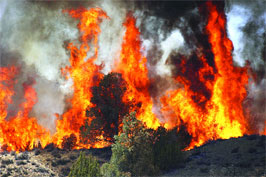 Before firefighters declared containment on Sunday, the Zaca Fire burnt 240,000 acres, making it the second largest wildfire in recorded state history. Now the long process of recovery begins.
Before firefighters declared containment on Sunday, the Zaca Fire burnt 240,000 acres, making it the second largest wildfire in recorded state history. Now the long process of recovery begins.By Earl Bates
Effects of the enormous Zaca Fire will be felt for a long time, but the recovery is likely to begin soon.
Kevin Cooper, Los Padres National Forest wildlife biologist, says, “Of course, it affects all wildlife differently, but there are a couple of general statements you could make about the affects on wildlife.”
Many members of the wildlife community escaped being seared by the fire, but many didn’t. “And it depends on what we call wildlife, if you include all of the invertebrates, which is a huge portion of the living biota out there, it’s a lot more that’s being burned up.”
The wildlife that has survived the fire must now find suitable habitat in an austere landscape, and the flora is beginning a vivid natural cycle of regeneration and succession.
The Zaca Fire started on July 4 and was “contained” on Sunday, with full control anticipated by October. With a perimeter that encompasses an area of 240,000 acres, it’s the second largest wildfire in the recorded history of California.
“It’s going well, actually, the fire’s looking like it’s going to be in good shape.” said forest botanist Lloyd Simpson from his station at the Richardson Fire Camp. “We are still very cautious because of the history of how this fire has acted. We have some really nasty weather coming up with these 100-plus temperatures and very low humidities, so they are keeping quite a vigilant watch on it.”
The work of more than 3,000 firefighters has protected countless lives, dwellings and structures from the extensive Zaca Fire. About 40 injuries have been reported and one outbuilding is listed as destroyed.
The story of the loss, survival and recovery of the wildlife and plants that reside in the habitats of this Mediterranean forest is a window into the functioning of a fire-cycle ecosystem.
Ojai residents have been concerned about the welfare of the wildlife affected by the fire. What are the animals doing and where are they going?
“First of all, they are just fleeing the fire, so they are not headed anywhere except away from flames.” said Cooper. “Once it settles down, then they will be going into any kind of habitat that’s appropriate for them.”
Most of the larger wildlife had time to flee and avoid the flames, although some were unable to escape as the fire burned very quickly.
“Occasionally we see a deer or a bear get caught up in some heavy brush and may not make it, but it’s not that common.” Many of the small burrowing mammals and some of the reptiles and amphibians went underground and were probably protected, and birds flew, said Cooper.
The animals then just followed their senses. “A bear, for instance, can wander for miles and find unburned habitat that has the prey species, the plants and animals they need. They can sniff it out from miles away, they are pretty good about figuring that out.”
Some species like foxes and bobcats, and their prey, the wood rats, rely on having a lot of older, heavier brush nearby. So they may be more distressed than other animals from loss of habitat.
“Once they have made it out of the fire they are still not out of the frying pan,” said Cooper. As the various species try to locate suitable habitat, they probably encounter others of their own species already resident there, and other refugees. “There may not be room, in the ecological sense, for everybody to fit into the perimeter around the fire.”
Although individual animals have been lost directly to the flames and others have a diminished access to habitat, Cooper has not seen loss of any species. “If you are talking in terms of populations and not just individuals, then they are doing fine and they will reinhabit those burned regions when they regrow.”
But no complete census has been made. A number of rare species, including the California spotted owl, are know to have lived in the area of the Zaca Fire. “They didn’t lose their basic canopy cover of old growth timber in there, that’s still standing, at least on Big Pine Mountain,” said Cooper. “But whether the spotted owl still have their prey species and will go back immediately is unknown.”
Cooper and Simpson agree that one significant fact about this fire is its extra-large size. “But interestingly, there are still lots of unburned patches of forest, so it’s a mosaic,” said Simpson.
“I flew over it yesterday and I noticed a lot of the lower drainages where there are trees, vegetation is still there, it’s still green and it looks like it is going to survive,” he said. “The mosaic is really what we want, it adds a lot of ecological variety to the landscape, so we get a much bigger diversity of species. Where we had only a handful of plants we could have thousands after the fire. It’s amazing, it’s interesting to see that.”
No comments:
Post a Comment